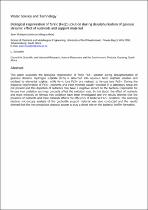 ResearchSpace
ResearchSpace
Biological regeneration of ferric ("Fe3+") solution during desulphurisation of gaseous streams: effect of nutrients and support material
JavaScript is disabled for your browser. Some features of this site may not work without it.
- ResearchSpace
- →
- Research Publications/Outputs
- →
- Journal Articles
- →
- View Item
| dc.contributor.author |
Mulopo, J

|
|
| dc.contributor.author |
Schaefer, Lisa M

|
|
| dc.date.accessioned | 2016-02-23T09:26:16Z | |
| dc.date.available | 2016-02-23T09:26:16Z | |
| dc.date.issued | 2015-03 | |
| dc.identifier.citation | Mulopo, J and Schaefer, L. 2015. Biological regeneration of ferric ("Fe3+") solution during desulphurisation of gaseous streams: effect of nutrients and support material. Water Science and Technology, vol. 71(11), pp. 1672-1678 | en_US |
| dc.identifier.issn | 0273-1223 | |
| dc.identifier.uri | http://www.ncbi.nlm.nih.gov/pubmed/26038932 | |
| dc.identifier.uri | http://hdl.handle.net/10204/8422 | |
| dc.description | Copyright: 2015 IWA Publishing. Due to copyright restrictions, the attached PDF file only contains the abstract of the full text item. For access to the full text item, please consult the publisher's website. The definitive version of the work is published in Water Science and Technology, vol. 71(11), pp. 1672-1678 | en_US |
| dc.description.abstract | This paper evaluates the biological regeneration of ferric Fe3+ solution during desulphurisation of gaseous streams. Hydrogen sulphide (H2S) is absorbed into aqueous ferric sulphate solution and oxidised to elemental sulphur, while ferric ions Fe3+ are reduced to ferrous ions Fe2+. During the industrial regeneration of Fe3+, nutrients and trace minerals usually provided in a laboratory setup are not present and this depletion of nutrients may have a negative impact on the bacteria responsible for ferrous iron oxidation and may probably affect the oxidation rate. In this study, the effect of nutrients and trace minerals on ferrous iron oxidation have been investigated and the results showed that the presence of nutrients and trace minerals affects the efficiency of bacterial Fe2+oxidation. The scanning electron microscopy analysis of the geotextile support material was also conducted and the results showed that the iron precipitate deposits appear to play a direct role on the bacterial biofilm formation. | en_US |
| dc.language.iso | en | en_US |
| dc.publisher | IWA publishing | en_US |
| dc.relation.ispartofseries | Workflow;15241 | |
| dc.subject | Desulphurisation of gaseous streams | en_US |
| dc.subject | "Fe2+" oxidation | en_US |
| dc.subject | Ferric Fe3+ solution | en_US |
| dc.subject | Nutrients and trace minerals | en_US |
| dc.title | Biological regeneration of ferric ("Fe3+") solution during desulphurisation of gaseous streams: effect of nutrients and support material | en_US |
| dc.type | Article | en_US |
| dc.identifier.apacitation | Mulopo, J., & Schaefer, L. M. (2015). Biological regeneration of ferric ("Fe3+") solution during desulphurisation of gaseous streams: effect of nutrients and support material. http://hdl.handle.net/10204/8422 | en_ZA |
| dc.identifier.chicagocitation | Mulopo, J, and Lisa M Schaefer "Biological regeneration of ferric ("Fe3+") solution during desulphurisation of gaseous streams: effect of nutrients and support material." (2015) http://hdl.handle.net/10204/8422 | en_ZA |
| dc.identifier.vancouvercitation | Mulopo J, Schaefer LM. Biological regeneration of ferric ("Fe3+") solution during desulphurisation of gaseous streams: effect of nutrients and support material. 2015; http://hdl.handle.net/10204/8422. | en_ZA |
| dc.identifier.ris | TY - Article AU - Mulopo, J AU - Schaefer, Lisa M AB - This paper evaluates the biological regeneration of ferric Fe3+ solution during desulphurisation of gaseous streams. Hydrogen sulphide (H2S) is absorbed into aqueous ferric sulphate solution and oxidised to elemental sulphur, while ferric ions Fe3+ are reduced to ferrous ions Fe2+. During the industrial regeneration of Fe3+, nutrients and trace minerals usually provided in a laboratory setup are not present and this depletion of nutrients may have a negative impact on the bacteria responsible for ferrous iron oxidation and may probably affect the oxidation rate. In this study, the effect of nutrients and trace minerals on ferrous iron oxidation have been investigated and the results showed that the presence of nutrients and trace minerals affects the efficiency of bacterial Fe2+oxidation. The scanning electron microscopy analysis of the geotextile support material was also conducted and the results showed that the iron precipitate deposits appear to play a direct role on the bacterial biofilm formation. DA - 2015-03 DB - ResearchSpace DP - CSIR KW - Desulphurisation of gaseous streams KW - "Fe2+" oxidation KW - Ferric Fe3+ solution KW - Nutrients and trace minerals LK - https://researchspace.csir.co.za PY - 2015 SM - 0273-1223 T1 - Biological regeneration of ferric ("Fe3+") solution during desulphurisation of gaseous streams: effect of nutrients and support material TI - Biological regeneration of ferric ("Fe3+") solution during desulphurisation of gaseous streams: effect of nutrients and support material UR - http://hdl.handle.net/10204/8422 ER - | en_ZA |





